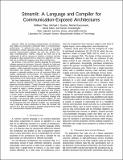StreamIt: A Language and Compiler for Communication-Exposed Architectures
Author(s)
Thies, William; Gordon, Michael I.; Karczmarek, Michal; Maze, David; Amarasinghe, Saman P.
DownloadCS026.pdf (709.6Kb)
Metadata
Show full item recordAbstract
With the increasing miniaturization of transistors, wire delays are becoming a dominant factor in microprocessor performance. To address this issue, a number of emerging architectures contain replicated processing units with software-exposed communication between one unit and another (e.g., Raw, SmartMemories, TRIPS). However, for their use to be widespread, it will be necesary to develop a common machine language to allow programmers to express an algorithm in a way that can be efficiently mapped across these architectures. We propose a new common machine language for grid-based software-exposed architectures: StreamIt. StreamIt is a high-level programming language with explicit support for streaming computation. Unlike sequential programs with obscured dependence information and complex communication patterns, a stream program is naturally written as a set of concurrent filters with regular steady-state communication. The language imposes a hierarchical structure on the stream graph that enables novel representations and optimizations within the StreamIt compiler. We have implemented a fully functional compiler that parallelizes StreamIt applications for Raw, including several load-balancing transformations. Though StreamIt exposes the parallelism and communication patterns of stream programs, analysis is needed to adapt a stream program to a software-exposed processor. We describe a partitioning algorithm that employs fission and fusion transformations to adjust the granularity of a stream graph, a layout algorithm that maps a stream graph to a given network topology, and a scheduling strategy that generates a fine-grained static communication pattern for each computational element. Using the cycle-accurate Raw simulator, we demonstrate that the StreamIt compiler can automatically map a high-level stream abstraction to Raw. We consider this work to be a first step towards a portable programming model for communication-exposed architectures.
Date issued
2003-01Series/Report no.
Computer Science (CS);
Keywords
communication-exposed architectures, StreamIt, Raw, software-exposed architectures, streaming application domain